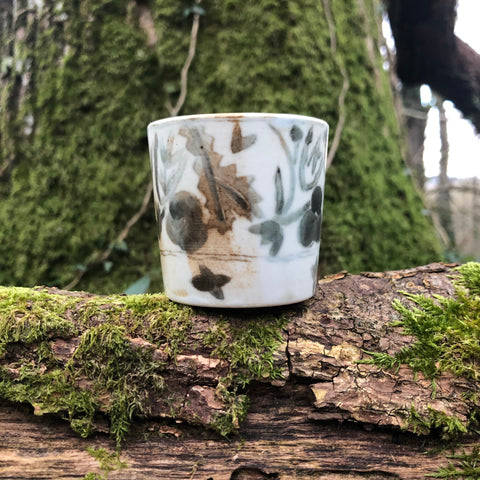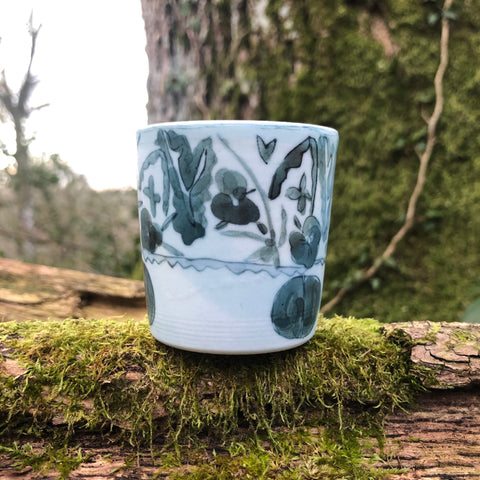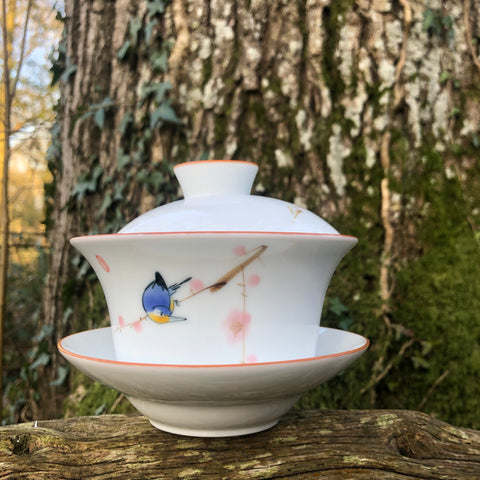320ml Midnight Blue Tokoname ‘Teapot’ with basket shaped strainer : [Yamafusa Kiln]l
This traditional "Tokoname" [see below] Japanese ceramic Kyusu teapot is specially designed to brew green tea. It is perfect for one or two people. Holding 320ml of tea it has a removable mesh filter / cup strainer especially useful as Japanese teas can contain very small leaf particles.
About the Yamafusa Kiln
- Kiln : YAMAFUSA Kiln ( 山房 窯 )
- Name of Master : Takehiko KOIE ( 鯉江 健彦 )
- City & Year of birth : Born in 1964 in Tokoname City, Aichi Prefecture.
- Education : Received training as research student at Aichi Pref Ceramic Tech Center
- Signature style of tea pots : Founded in 1904, Yamfusa Kiln has been a pottery in Tokoname for over 100 years, and current Yamfusa is the fourth generation. Taking advantage of the traditional techniques of Tokoname ware, he strive for sincere pottery production. In addition to teapots, he has many hit works such as stone-style vases.
To learn more about the different types of Tokoname Teapots including which may be the best choice for your tea you can read our blog here
Tales of the Tea Trade : Tokoname
Rob : Extract from our our book Tales of the tea trade :
The Tokoname region as it is considered the teaware capital of Japan. This area’s link with pottery dates back to 1100 and is believed to be the oldest in Japan. However, it wasn’t until the start of the Edo period (1603–1868) that this area became important. In early times it focused mostly on vases and jars, but this period also produced the early matcha bowls in the form of yama-chawans (mountain tea bowls). These were coarsely finished bowls with little refinement, but beautiful in their simplicity.
Today Tokoname is famous for its redware teapots (kyusu), introduced in the early 1860s. Other teapots for green tea had been produced from early in the nineteenth century in Tokoname, but this new style became very popular. Again it was influenced by China, whose own redware teapots were the typical teaware used at this time. The name comes from the deep red, iron-rich clay from which it is made. Its use in Japan had a big effect on Tokoname’s ceramic industry, with an influx of new potters who specialized in making redware teapots. This was helped by the visit of a Chinese potter called Jin Shi Heng who, in 1878, was invited to teach Chinese techniques for making teapots, greatly accelerating development and increasing quality. This, combined with a period of rapid industrialization, eventually meant mass-production hit Tokoname towards the end of the nineteenth century, with much small-scale domestic production replaced with industrial-scale manufacturing. However, Tokoname today is a place of great diversity, incorporating both small and large-scale manufacture.
There are three possible forms of Tokoname teapots, categorized according to where the handle is sited. A yokode kyusu has it on the side, an ushirode kyusu has it at the back and an uwade kyusu has a handle on the top. The most typical modern type is the yokode kyusu, which is the one we use at Comins. This style can be traced back to the end of the Song dynasty (960–1279) in China for the preparation of powdered tea. It has been adapted perfectly over time to meet Japanese needs, incorporating a fine mesh to prevent the fine particles of tea from coming out. Each one is balanced according to the potter’s preferences. Customers often comment how simple yet effective their design is, not knowing that the concept has not really changed in 900 years!


![320ml Midnight Blue Tokoname ‘Teapot’ with basket shaped strainer : [Yamafusa Kiln]l](http://cominstea.com/cdn/shop/products/image_c10f7300-9291-4ef2-a469-2819b56c3223_1024x1024.jpg?v=1669814373)
![320ml Midnight Blue Tokoname ‘Teapot’ with basket shaped strainer : [Yamafusa Kiln]l](http://cominstea.com/cdn/shop/products/image_c10f7300-9291-4ef2-a469-2819b56c3223_grande.jpg?v=1669814373)
![320ml Midnight Blue Tokoname ‘Teapot’ with basket shaped strainer : [Yamafusa Kiln]l](http://cominstea.com/cdn/shop/products/image_b4b6d70d-6936-4a28-8454-b57d00f64f24_grande.jpg?v=1669814373)
![320ml Midnight Blue Tokoname ‘Teapot’ with basket shaped strainer : [Yamafusa Kiln]l](http://cominstea.com/cdn/shop/products/image_6e0a153e-f411-4a7c-aa89-a0eb97995ea0_grande.jpg?v=1669814373)
![320ml Midnight Blue Tokoname ‘Teapot’ with basket shaped strainer : [Yamafusa Kiln]l](http://cominstea.com/cdn/shop/products/image_d2e6c504-40ee-4a70-a9a5-0295f094663f_grande.jpg?v=1669814373)
![320ml Midnight Blue Tokoname ‘Teapot’ with basket shaped strainer : [Yamafusa Kiln]l](http://cominstea.com/cdn/shop/products/image_d921e727-c035-4910-b324-ff78e9ae8750_grande.jpg?v=1616178148)
![320ml Midnight Blue Tokoname ‘Teapot’ with basket shaped strainer : [Yamafusa Kiln]l](http://cominstea.com/cdn/shop/products/image_84038042-b531-4bec-a30b-481c940808ee_grande.jpg?v=1616178148)
![320ml Midnight Blue Tokoname ‘Teapot’ with basket shaped strainer : [Yamafusa Kiln]l](http://cominstea.com/cdn/shop/products/image_77766119-1eaf-4909-bb1b-52ab79ba1068_grande.jpg?v=1616178148)
![320ml Midnight Blue Tokoname ‘Teapot’ with basket shaped strainer : [Yamafusa Kiln]l](http://cominstea.com/cdn/shop/products/image_97b27103-cd9d-4571-ad21-748e572fd18f_grande.jpg?v=1616178148)
![320ml Midnight Blue Tokoname ‘Teapot’ with basket shaped strainer : [Yamafusa Kiln]l](http://cominstea.com/cdn/shop/products/image_2dddae06-cd16-4da8-9d11-6cafbc14a08f_grande.jpg?v=1616178148)



